Marketing
Top 10 Best Effective Practical Marketing Modules or Frameworks for Startups, Entrepreneurs, and Businesses
10.02.2025
By shaikh asif

Marketing
10.02.2025
By shaikh asif
In a rapidly evolving business landscape, effective marketing is the cornerstone of growth for startups, entrepreneurs, and businesses. However, navigating the complexities of marketing without a solid framework can be overwhelming. That’s where proven marketing modules and frameworks come into play—they provide a structured approach to reaching your audience, increasing brand visibility, and achieving sustainable business success.
In this article we will walk you through the top 10 most effective and practical marketing frameworks, offering step-by-step guidance on how to implement them in your business. Each framework is tailored to help you understand your market, connect with your audience, and drive growth. Along the way, we’ll also highlight the critical role that a strong brand identity—crafted with precision and expertise—plays in maximizing the impact of these frameworks.
At Alitestar, we specialize in delivering premium branding, Iconic logo design, and authentic brand identity services that empower businesses to stand out and thrive. By the end of this article, you'll not only be equipped with powerful marketing tools but also understand how Alitestar can help you elevate your brand to new heights.
The STP framework is a foundational marketing strategy that involves segmenting your market, targeting the most promising segments, and positioning your brand effectively within those segments. This framework is crucial for startups and businesses looking to tailor their marketing efforts to specific audiences, ensuring that their message resonates and drives engagement.
Application:
Segmentation: Start by dividing your market into distinct groups based on factors such as demographics, behavior, and needs. For example, a tech startup might segment its audience into early adopters, tech enthusiasts, and mainstream consumers.
Targeting: Once you’ve identified your segments, select the ones that align best with your business goals and resources. Focus your marketing efforts on these target segments to maximize efficiency.
Positioning: Finally, position your brand in a way that highlights its unique value proposition to the selected segments. This involves crafting messaging that clearly communicates why your brand is the best choice for their specific needs.
A strong brand identity is crucial to effective positioning. At Alitestar, we help you develop a compelling brand story and visual identity that speaks directly to your target audience, enhancing the effectiveness of your STP strategy.
.gif)
Segmentation:
Divide your market into distinct customer segments based on demographics, behavior, etc.
Example: Segment your market into small businesses, freelancers, and large enterprises.
Targeting:
Select the segment(s) you will focus on.
Example: Target freelancers with a budget-friendly version of your software.
Positioning:
Position your product in a way that appeals to your target segment.
Example: Market your software as the best value-for-money tool for freelancers to manage their projects efficiently.
The AIDA model is a classic marketing framework that guides the customer journey from awareness to conversion. It’s a powerful tool for creating marketing campaigns that not only capture attention but also build interest, foster desire, and prompt action.
Application:
Attention: Start by crafting eye-catching content or ads that grab your audience’s attention. Use bold visuals, intriguing headlines, or surprising statistics.
Interest: Once you have their attention, keep them engaged by providing valuable information or telling a compelling story. This could be in the form of a blog post, video, or social media content.
Desire: Build desire by highlighting the benefits of your product or service. Case studies, testimonials, and demonstrations can be particularly effective.
Action: Finally, guide your audience to take action, whether it’s making a purchase, signing up for a newsletter, or downloading a resource. Make sure the call to action is clear and compelling.
Visual appeal is key to capturing and retaining attention. Our expert team at Alitestar ensures your brand identity is visually striking and memorable, making it easier to move your audience through the AIDA stages.
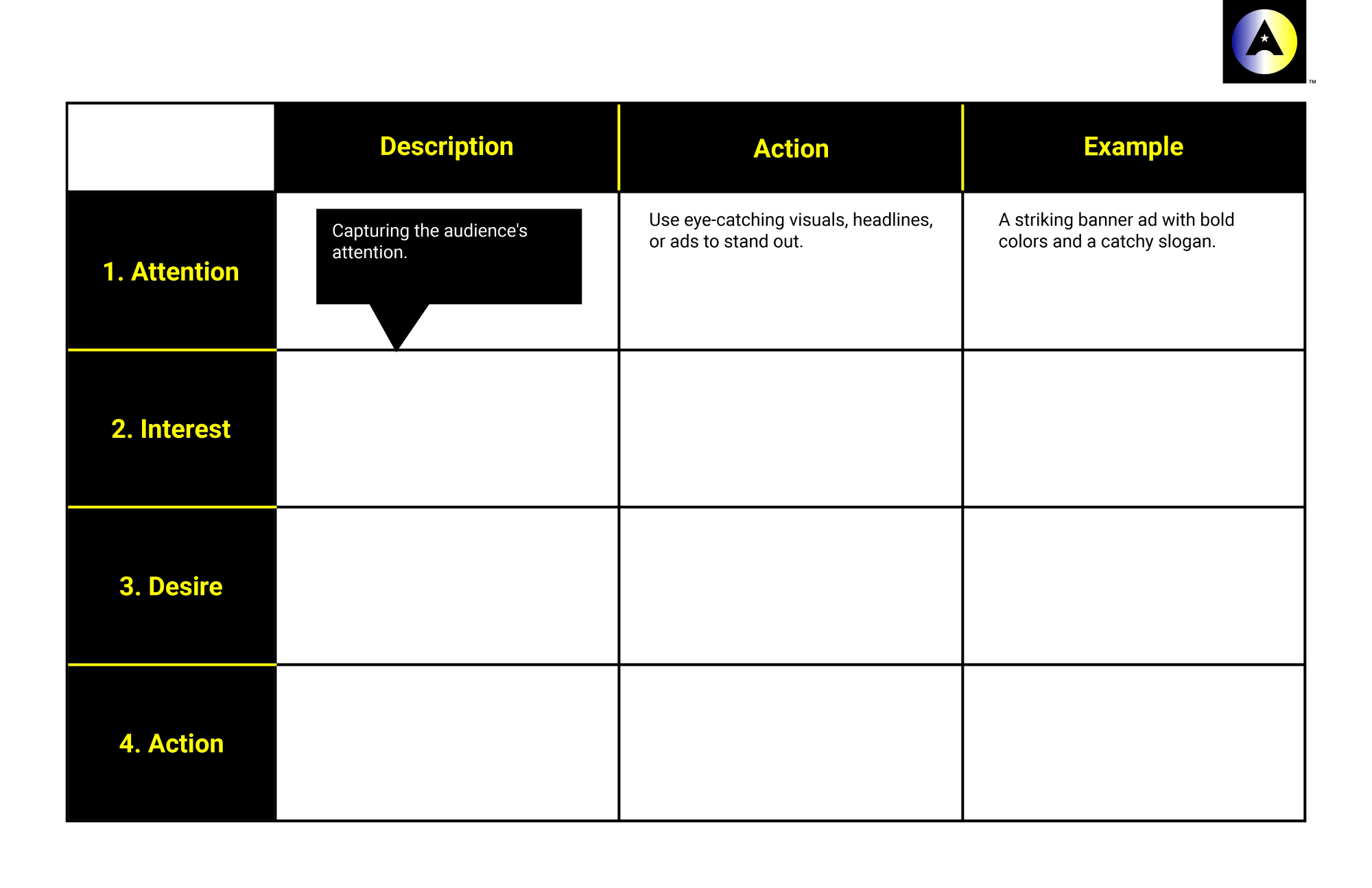
Attention:
Grab your audience’s attention with eye-catching content.
Example: Create a bold, visually appealing social media post about your product launch.
Interest:
Build interest by highlighting key features and benefits.
Example: Share a video demo showcasing how your software solves a common problem.
Desire:
Foster a desire for your product by showing its impact on customers' lives.
Example: Publish customer testimonials that demonstrate how your software has improved their efficiency.
Action:
Encourage the final step with a clear call to action.
Example: Include a “Sign Up Now” button with a limited-time discount offer.
The 4Ps framework—Product, Price, Place, and Promotion—is a time-tested strategy that helps businesses develop a comprehensive marketing plan. It ensures that all aspects of your marketing mix work together to achieve your business goals.
Application:
Product:
Define what makes your product or service unique. Ensure that it meets the needs of your target audience and stands out from the competition.
Price:
Set a pricing strategy that reflects your brand’s value while remaining competitive. Consider factors like cost, market demand, and perceived value.
Place:
Decide where and how your product will be distributed. This could be through online platforms, physical stores, or both.
Promotion:
Develop a promotion strategy that includes advertising, sales promotions, and public relations efforts to raise awareness and drive sales.
Branding plays a critical role in both the “Product” and “Promotion” elements of the 4Ps. A well-designed logo, strong brand identity, and cohesive branding strategy—services offered by Alitestar—can elevate your product and make your promotional efforts more effective.
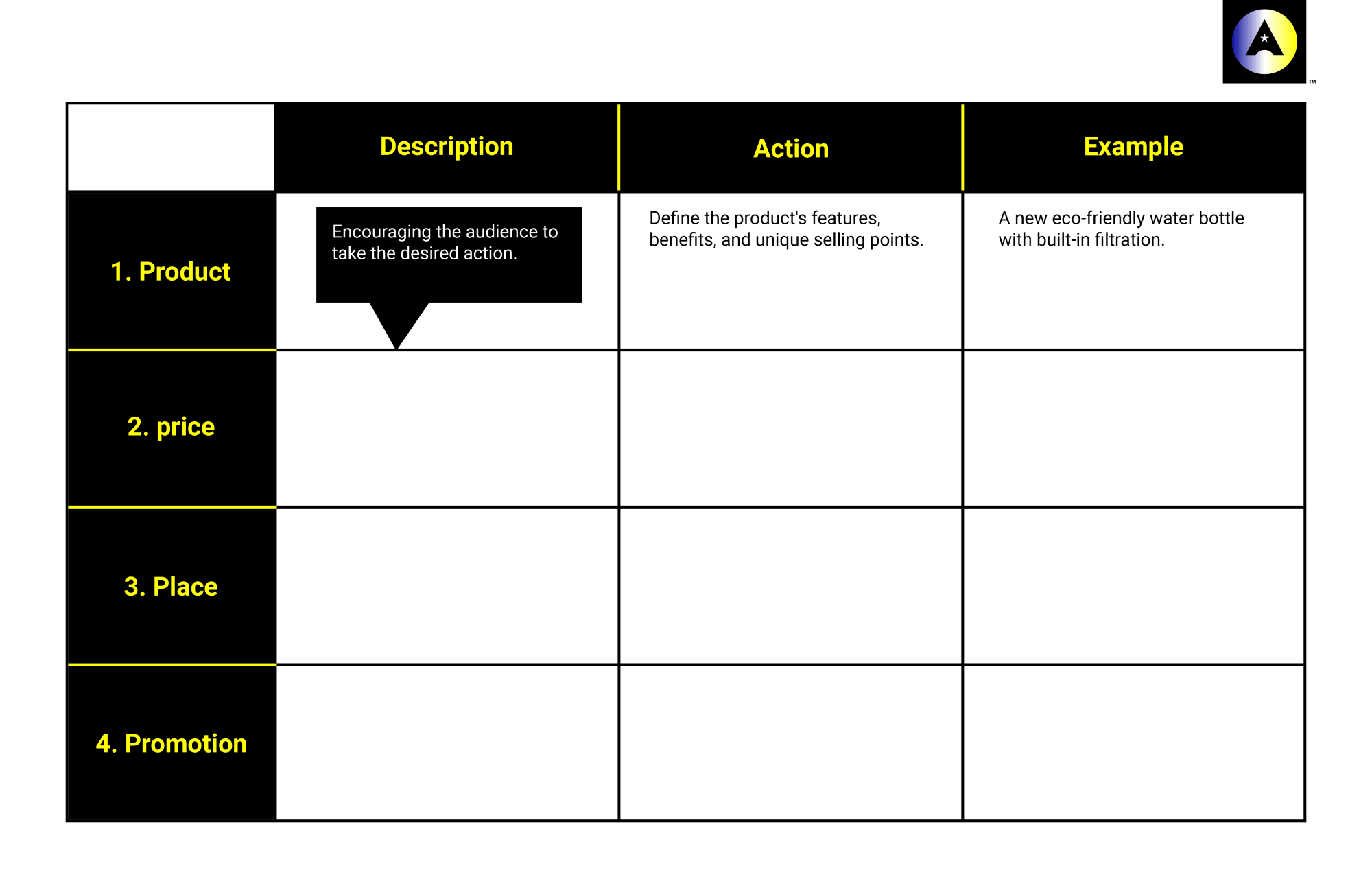
Product Innovation:
Innovate your product offering by adding new features or developing new products.
Example: Introduce AI-powered features in your existing software.
Process Innovation:
Improve the processes behind your product’s delivery.
Example: Implement automated customer support through chatbots.
Position Innovation:
Reposition your product to appeal to a different audience.
Example: Rebrand your software as a tool for creative professionals rather than just project managers.
Paradigm Innovation:
Challenge and change the fundamental business model.
Example: Shift from a one-time purchase model to a subscription-based model for your software.
The marketing funnel is a framework that visualizes the journey potential customers take from becoming aware of your brand to making a purchase and beyond. It helps businesses understand how to guide leads through each stage, from awareness to conversion.
Application:
Top of the Funnel (Awareness):
Use broad-reach tactics like social media, content marketing, and search engine marketing to attract potential customers.
Middle of the Funnel (Consideration):
Engage with leads through targeted content, email marketing, and webinars to address their specific needs and concerns.
Bottom of the Funnel (Conversion):
Convert leads into customers with compelling offers, personalized outreach, and strong calls-to-action.
Post-Purchase (Loyalty):
Continue nurturing the relationship with post-purchase follow-ups, loyalty programs, and exceptional customer service.
A consistent brand experience is essential at every stage of the funnel. Alitestar’s brand guidelines services ensure your branding remains cohesive and impactful throughout the customer journey.
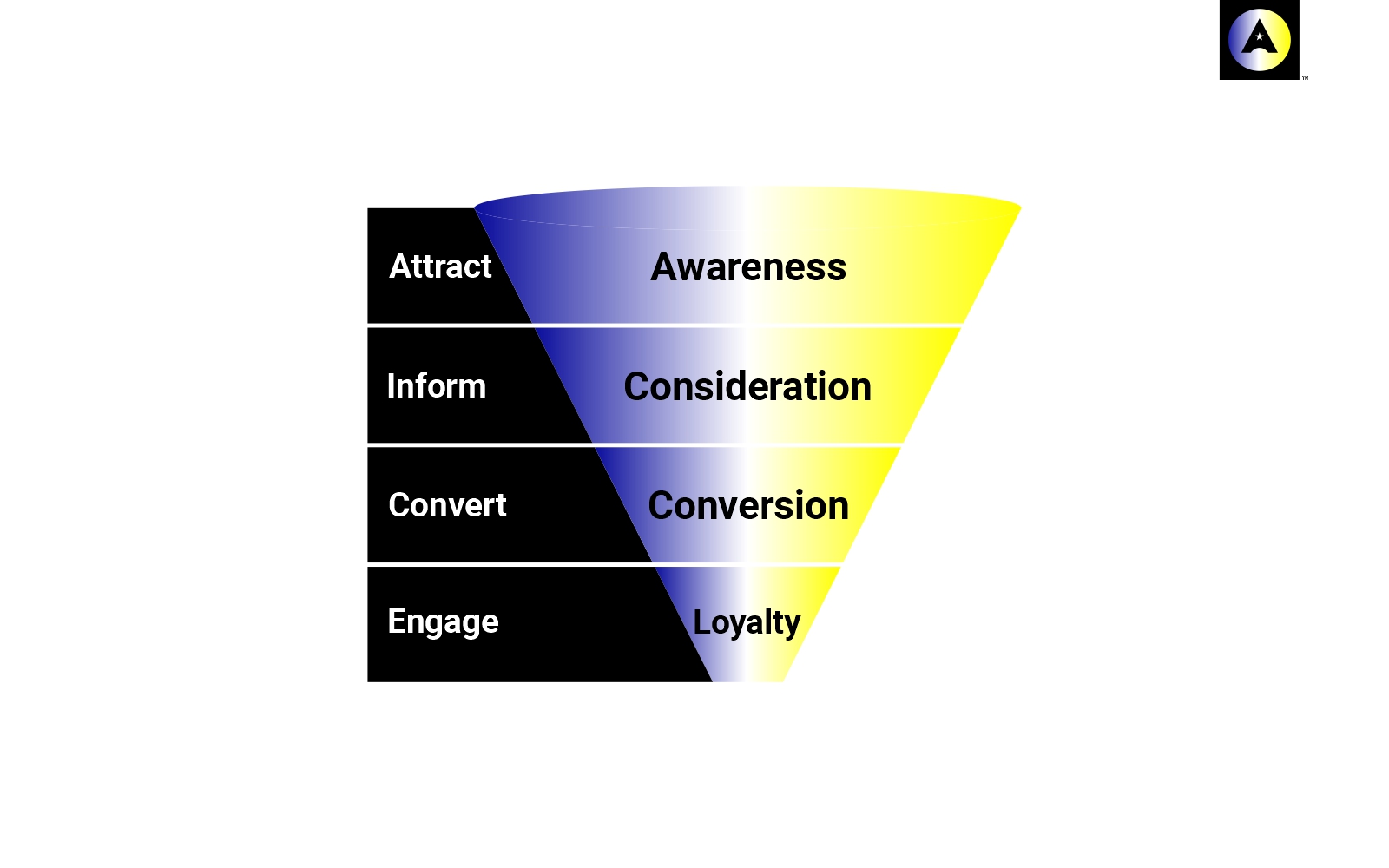
SWOT analysis is a strategic planning tool that helps businesses identify their strengths, weaknesses, opportunities, and threats. It’s essential for understanding your position in the market and developing strategies that leverage your strengths and mitigate risks.
Application:
Strengths:
Identify what your business does well—your unique selling points, resources, and competitive advantages.
Weaknesses:
Acknowledge areas where your business could improve, such as limited resources, gaps in expertise, or operational inefficiencies.
Opportunities:
Look for external factors that could benefit your business, like market trends, emerging technologies, or changing customer needs.
Threats:
Recognize potential challenges that could impact your business, such as new competitors, regulatory changes, or economic shifts.
A strong brand can be a significant strength in your SWOT analysis. Alitestar’s branding services can help you capitalize on your strengths and turn weaknesses into opportunities through effective brand positioning.
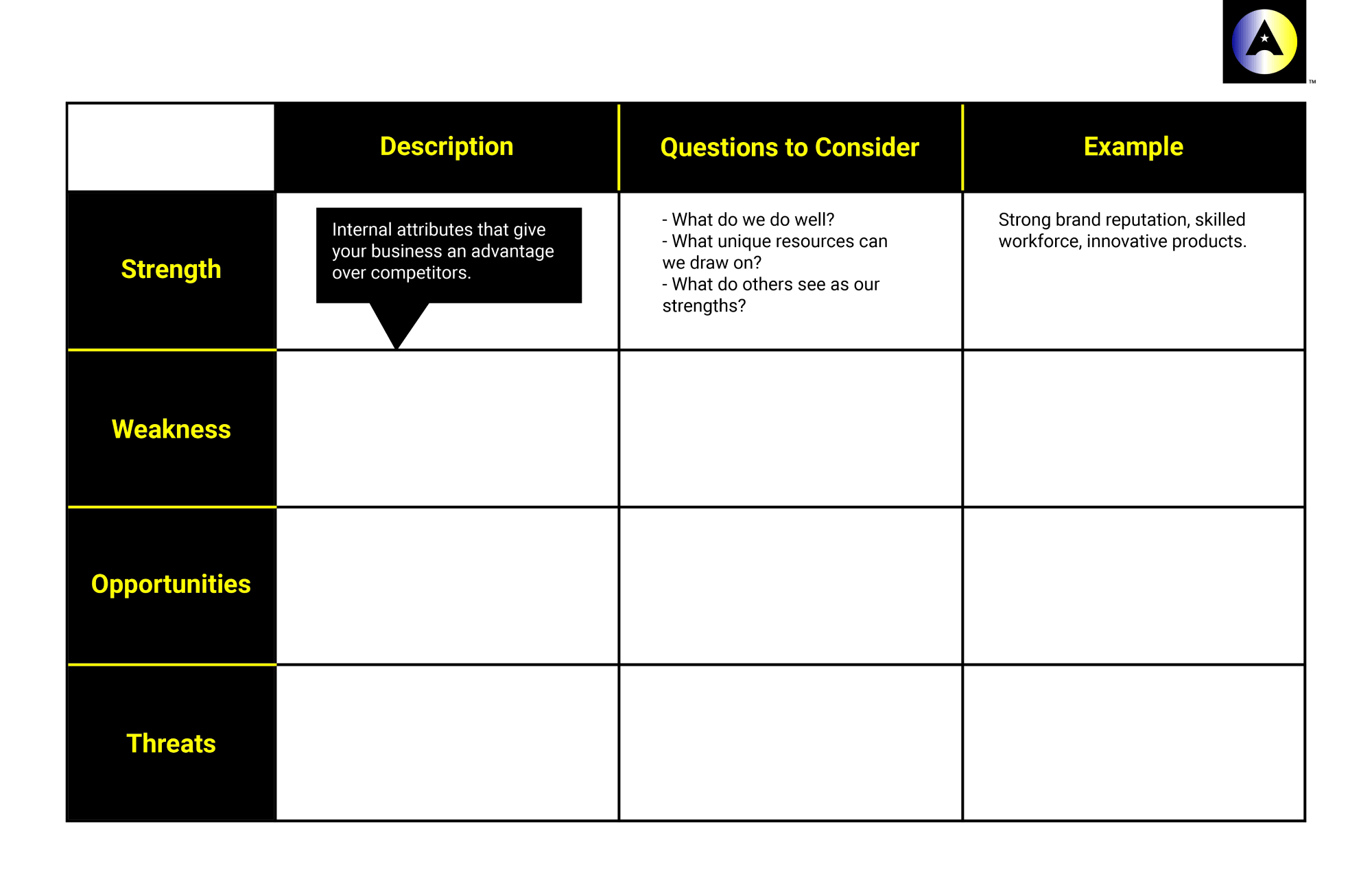
Identify Strengths:
List your business’s strengths (e.g., strong brand reputation, high customer satisfaction).
Example: Your business has a well-established online presence with a large, loyal customer base.
Identify Weaknesses:
List areas where your business may be lacking (e.g., limited product range, weak supply chain).
Example: Your product range is narrow, limiting customer choice.
Identify Opportunities:
Explore external opportunities (e.g., market trends, technological advancements).
Example: Rising demand for eco-friendly products that you could introduce to your line.
Identify Threats:
List potential threats (e.g., new competitors, changing regulations).
Example: A new competitor is entering your market with aggressive pricing strategies.
Action Plan:
Develop strategies to leverage strengths, address weaknesses, seize opportunities, and mitigate threats.
Example: Expand your product range by introducing eco-friendly options, using your strong brand to market these new products.
Growth hacking is a data-driven approach to marketing that focuses on rapid experimentation across different channels and strategies to identify the most effective ways to grow a business. It’s particularly useful for startups looking to scale quickly with limited resources.
Application:
Experimentation:
Continuously test new marketing ideas across various channels, such as social media, email, and paid ads, to see what drives the best results.
Data Analysis:
Use analytics tools to track the performance of your experiments. Focus on key metrics like customer acquisition cost (CAC), conversion rates, and retention rates.
Scaling Successes:
Once you identify what works, scale those efforts to maximize growth. This might involve doubling down on a successful ad campaign or expanding a high-performing content series.
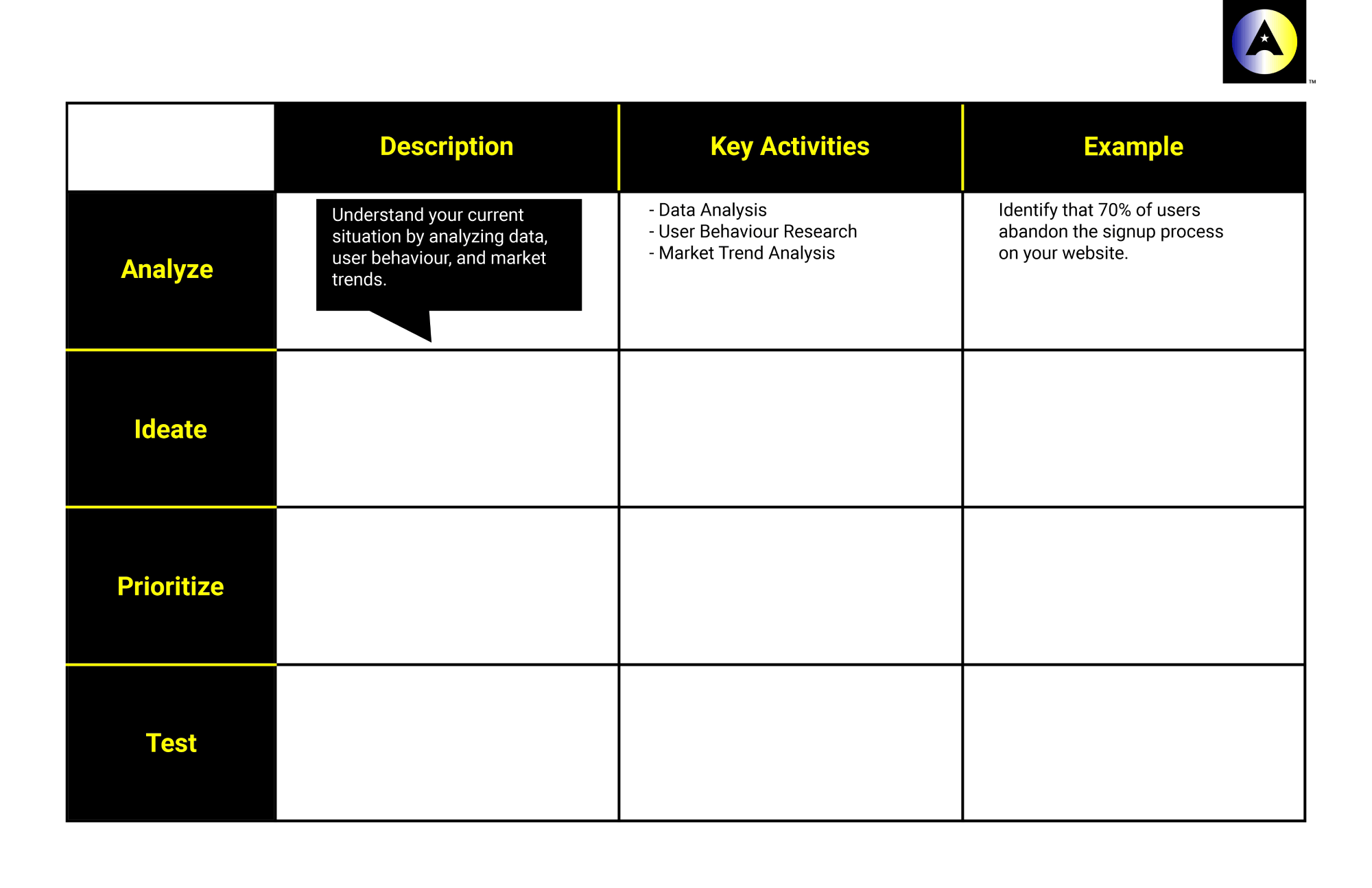
Acquisition:
Focus on attracting users to your product.
Example: Use social media ads to drive traffic to your software’s landing page.
Activation:
Ensure new users have a great first experience.
Example: Offer a free trial with a quick-start guide to help users see the value immediately.
Retention:
Keep users engaged and returning.
Example: Send personalized emails with tips and updates to keep users engaged.
Referral:
Encourage satisfied users to refer others.
Example: Introduce a referral program where users earn credits for each new user they bring.
Revenue:
Monetize your user base.
Example: Offer premium features that users can unlock through a subscription.
A cohesive brand identity can amplify the results of your growth hacking efforts by making your marketing messages more impactful and memorable. Alitestar’s branding services ensure that your brand is ready to scale along with your growth initiatives.
The Lean Startup methodology is a systematic approach to developing businesses and products. It emphasizes creating a minimum viable product (MVP), gathering customer feedback, and iterating based on that feedback to avoid wasting time and resources.
Application:
your MVP should make a strong first impression, and that starts with a powerful brand identity. Alitestar helps you create a brand that resonates with your target audience from the very beginning, increasing your chances of early success.
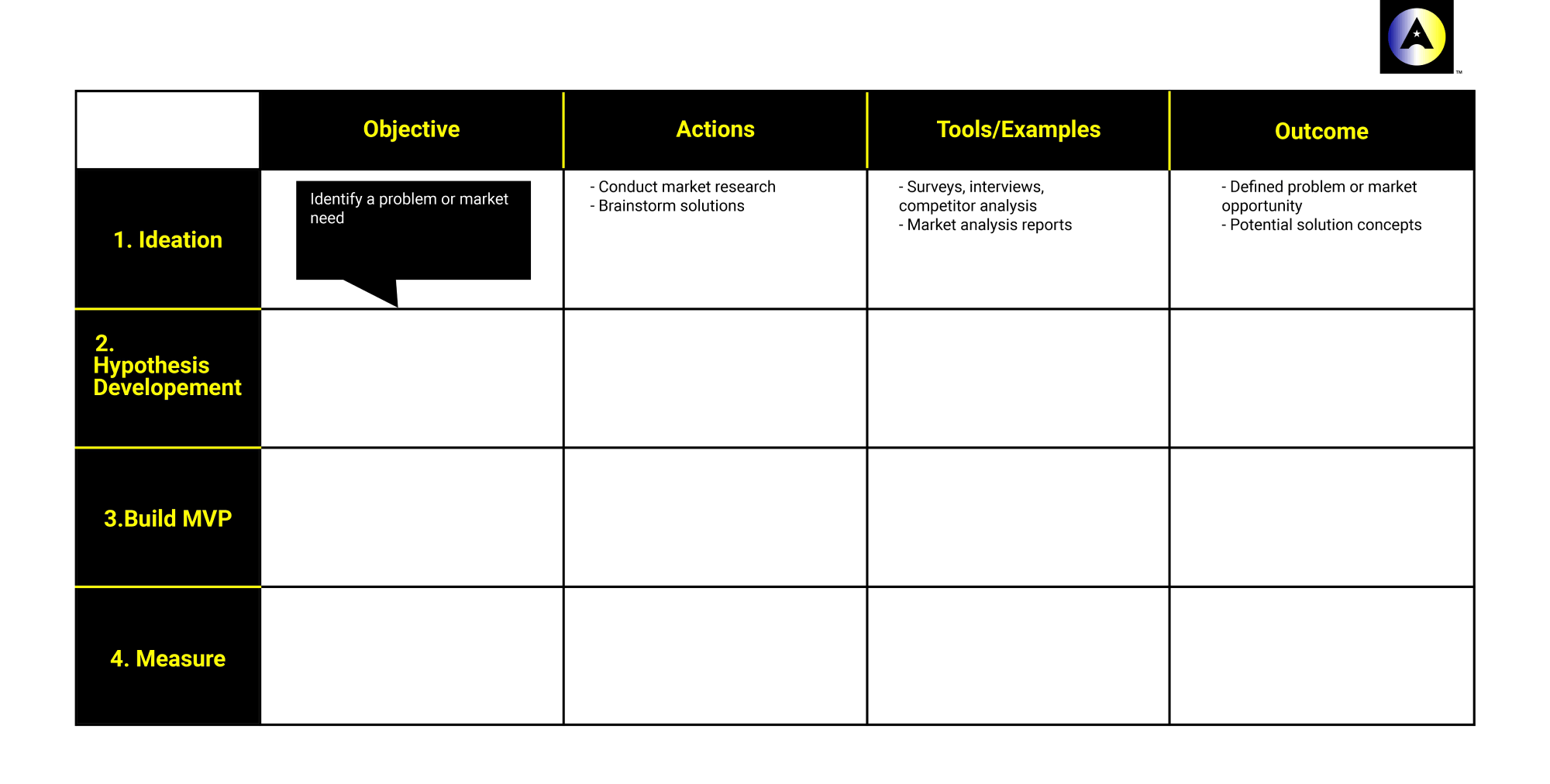
Build:
Create a Minimum Viable Product (MVP) to test your idea with minimal resources.
Example: Develop a basic version of your software with core features.
Measure:
Gather feedback from early users to understand what works and what doesn’t.
Example: Use surveys and analytics to collect user feedback on the MVP.
Learn:
Use the feedback to refine your product and improve it.
Example: Add or modify features based on user feedback to better meet their needs.
Iterate:
Continue to build, measure, and learn until you find a product-market fit.
Example: Releasing new versions of the software until it meets the demands of the target market.
The RACE planning framework provides a comprehensive structure for managing and optimizing digital marketing activities across the customer lifecycle. It focuses on reaching potential customers, encouraging interaction, converting leads, and fostering ongoing engagement.
Application:
Reach:
Use online marketing channels, such as SEO, content marketing, and social media, to increase your brand’s visibility and attract visitors to your website.
Act:
Encourage visitors to take action on your site, whether it’s signing up for a newsletter, downloading a resource, or engaging with your content.
Convert:
Turn engaged visitors into customers through personalized offers, lead nurturing, and optimized sales funnels.
Engage:
Build long-term relationships with your customers by providing exceptional service, encouraging reviews, and fostering a community around your brand.
To maximize the effectiveness of your RACE framework, your brand must be consistent and engaging across all digital channels. Alitestar’s branding services ensure that your brand is seamlessly integrated into every aspect of your digital marketing strategy.
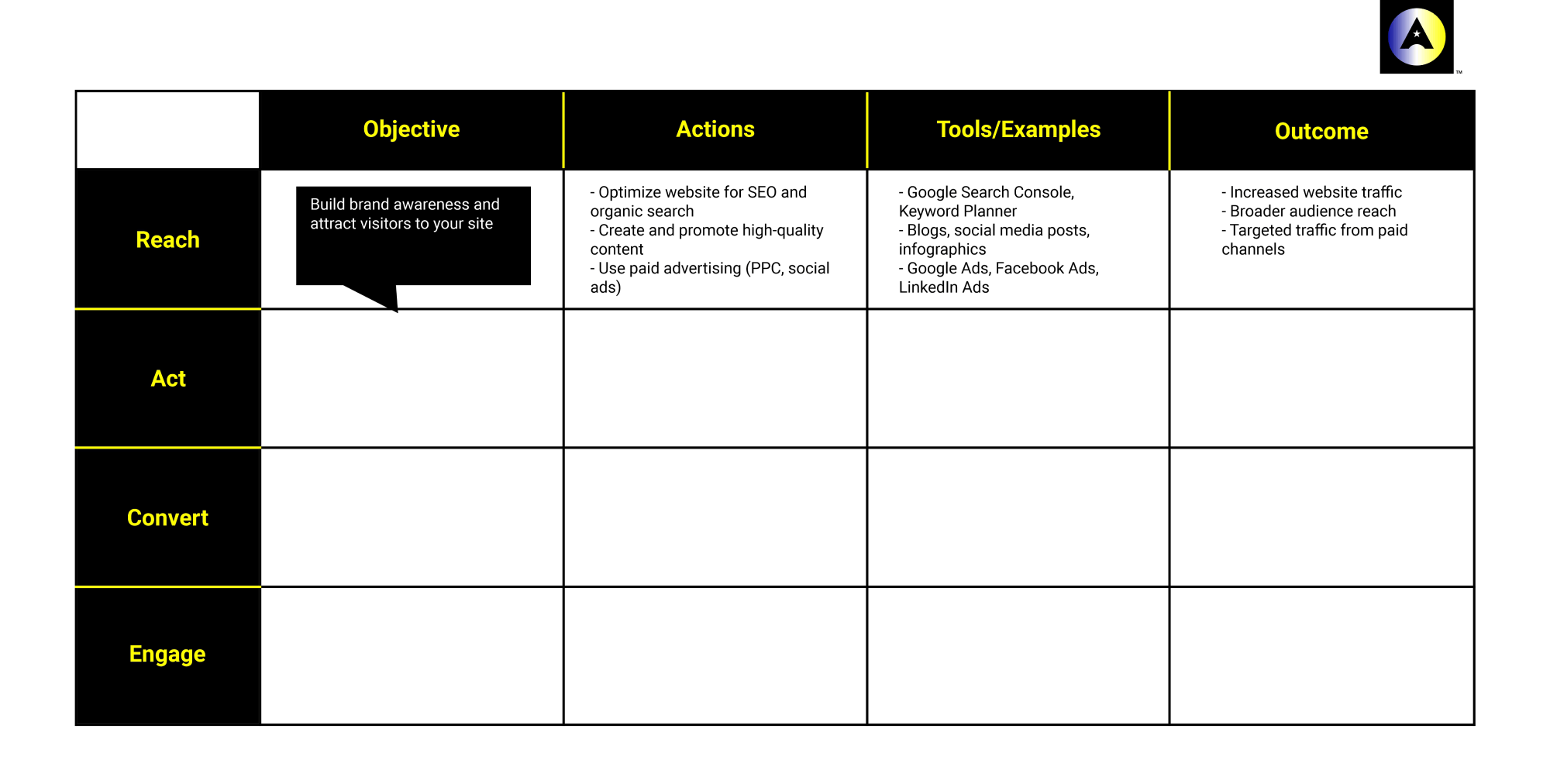
Reach:
Increase your brand’s visibility through digital marketing channels.
Example: Launch an SEO campaign to improve search engine rankings for your software.
Act:
Encourage interactions on your website.
Example: Add interactive demos and resources on your site to engage visitors.
Convert:
Turn visitors into customers.
Example: Use lead magnets like free trials or discounts to convert visitors into paying users.
Engage:
Foster long-term customer relationships.
Example: Create a community forum where users can share tips and experiences with your software.
Content marketing involves creating and distributing valuable, relevant, and consistent content to attract and engage a clearly defined audience. This framework is ideal for businesses looking to build long-term relationships with their customers by providing ongoing value.
Application:
Content Strategy:
Start with a clear content strategy that aligns with your business goals and addresses the needs of your target audience. Define your content types, topics, and distribution channels.
Content Creation:
Produce high-quality content that resonates with your audience. This could include blog posts, videos, podcasts, and infographics.
Content Distribution:
Share your content through the appropriate channels, such as social media, email newsletters, and your website, to reach your audience effectively.
Content Measurement:
Track the performance of your content using metrics like engagement, traffic, and conversion rates. Use these insights to refine your content strategy.
Your content should consistently reflect your brand’s identity and values. Alitestar helps you create a cohesive brand narrative that enhances your content marketing efforts and builds stronger connections with your audience.
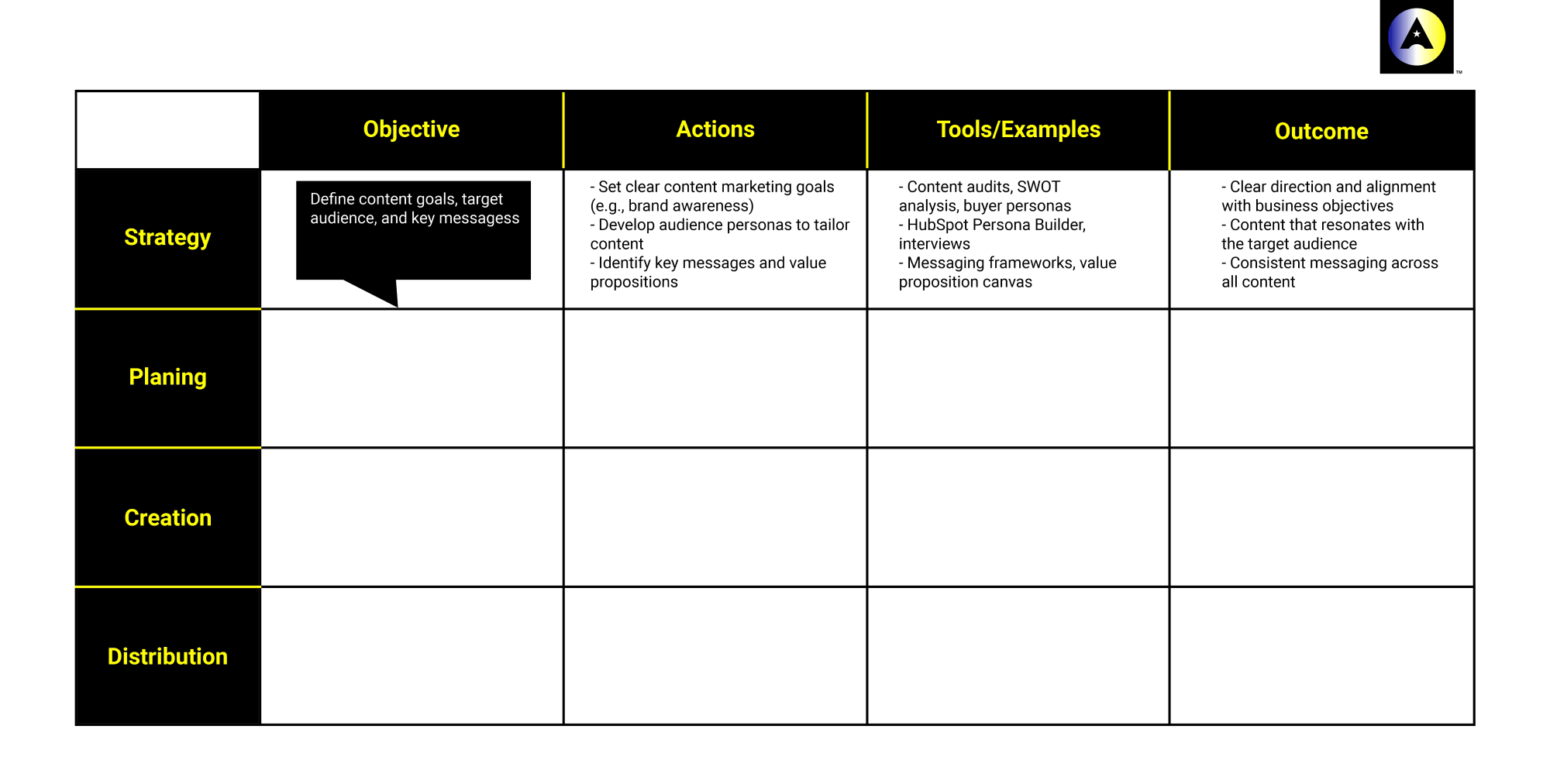
The right marketing framework can be a game-changer for your business, providing the structure and strategy needed to achieve your goals. By implementing these top 10 frameworks, you’ll be well-equipped to navigate the complexities of modern marketing and drive sustainable growth.
But remember, the effectiveness of any marketing strategy is amplified by a strong brand identity. At Alitestar, we specialize in creating premium branding solutions that not only make your business stand out but also enhance the impact of your marketing efforts. Whether you’re looking to build a new brand or refine your existing one, our expert team is here to help you succeed.
Ready to take your marketing to the next level? Contact Alitestar today and let’s start building a brand that drives results.


Shaikh Asif is an Award-winning designer, director, strategist, and educator. He’s the Lead Strategic Brand Designer and Art Director of The Alitestar— a strategic branding and design agency that helps startups, ambitious CEOs, and passionate entrepreneurs to achieve success and ultimately create unforgettable brand experiences.